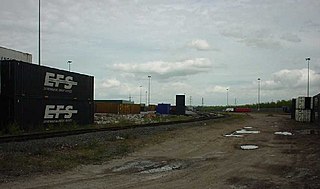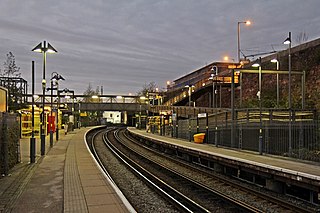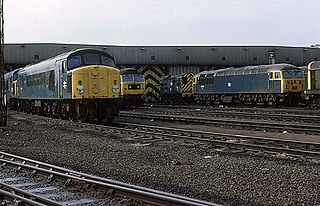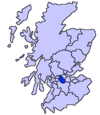
Motherwell is a town and former burgh in North Lanarkshire, Scotland, United Kingdom, south east of Glasgow. It has a population of around 32,120. Historically in the parish of Dalziel and part of Lanarkshire, Motherwell is the headquarters for North Lanarkshire Council. Geographically the River Clyde separates Motherwell from Hamilton to the west whereas the South Calder Water separates Motherwell from Carfin to the north-east and New Stevenston and Bellshill towards the north.

Bellshill Athletic Football Club is a Scottish football club based in the town of Bellshill, North Lanarkshire. It plays in the West of Scotland League Third Division.

Hams Hall is a place near Lea Marston in North Warwickshire, England, named after the former Hams Hall manor house. A power station at Hams Hall was constructed and operated in the late 1920s; a further two power stations began generating electricity in the 1940s and 1950s. By 1993 all three power stations had been closed and demolished and an industrial park Hams Hall Distribution Park was built. An intermodal rail terminal Hams Hall Rail Freight Terminal also operates at the site.

The British Rail Class 89 is a prototype electric locomotive. Only one was built, in 1986, by British Rail Engineering Limited's Crewe Works. It was used on test-trains on both the West Coast and East Coast Main Lines. The locomotive was fitted with advanced power control systems and developed more than 6,000 bhp. After being withdrawn in 1992, it was returned to service in 1996, before being again withdrawn in 2000. As of January 2021, it is in the final stages of an overhaul that will return it to the main line.

Wishaw is a large town in North Lanarkshire, Scotland, on the edge of the Clyde Valley, 15 miles (24 km) south-east of Glasgow city centre. The Burgh of Wishaw was formed in 1855 within Lanarkshire. it formed a joint large burgh with its neighbour Motherwell from 1920 until its dissolution when Scottish local authorities were restructured in 1975, and was then in Motherwell district within the Strathclyde region until 1996. The town is part of the Motherwell and Wishaw constituency. It has the postal code of ML2 and the dialling code 01698.

Bellshill is a town in North Lanarkshire in Scotland, ten miles southeast of Glasgow city centre and 37 mi (60 km) west of Edinburgh. Other nearby localities are Motherwell 2 mi (3 km) to the south, Hamilton 3 mi (5 km) to the southwest, Viewpark 1+1⁄2 mi (2.5 km) to the west, Holytown 2 mi (3 km) to the east and Coatbridge 3 mi (5 km) to the north. The town of Bellshill itself has a population of about 20,650. From 1996 to 2016, it was considered to be part of the Greater Glasgow metropolitan area; since then it is counted as part of a continuous suburban settlement anchored by Motherwell with a total population of around 125,000.

Cleland is a village near Motherwell and Wishaw in North Lanarkshire, Scotland. As of 2018, it has a population of about 3,000. The village has a strong coal mining heritage, and is a typical example of a working class village in North Lanarkshire and the Glasgow area. Due to its location, despite being at the heart of North Lanarkshire, the village is isolated, geographically and culturally, from surrounding towns such as Motherwell, Shotts and Wishaw.
MC Metals was a metal recycling company based in the Springburn area of Glasgow, Scotland.

Brunswick railway station serves the Toxteth district of Liverpool, England, on the Northern Line of the Merseyrail network. The station serves the nearby district of Dingle and is situated on a short section of track between two tunnels, between the now in-filled Toxteth and Harrington Docks. The station also serves businesses on the Brunswick Dock estate. The residential area of Grafton Street is reached by steps or ramp from the southbound platform.

The Canada Dock Branch is a 4-mile 59 chain long railway line in Liverpool, England. The line's route is from the large Edge Hill rail junction in the east of Liverpool to Seaforth Dock to the north. The line was originally built by the London and North Western Railway terminating at Canada Dock, with a later branch extension added to Alexandra Dock and links onto the MDHC railway lines. The line is not electrified.

Holyhead railway station serves the Welsh town of Holyhead on Holy Island, Anglesey. The station is the western terminus of the North Wales Coast Line 105+1⁄2 miles (170 km) west of Crewe and is managed by Transport for Wales Rail. It connects with the Port of Holyhead ferry terminal. The station is connected to the town centre by a stainless steel pedestrian/cycle bridge named The Celtic Gateway.

Carluke railway station is a railway station on the West Coast Main Line (WCML) that serves the town of Carluke, South Lanarkshire, Scotland. The station is managed by ScotRail and is predominantly served by Argyle Line commuter trains running between Lanark and Glasgow Central. The station lies at the western edge of the town, and enjoys panoramic views of the Clyde Valley and beyond to the hills of Lanarkshire and Ayrshire.
Holytown is a village situated to the east of Bellshill and north of Motherwell in North Lanarkshire, Scotland. Most local amenities are shared with the adjacent villages of Carfin, Newarthill and New Stevenston which have a combined population of around 20,000 across the four localities.

Toton Traction Maintenance Depot or Toton Sidings is a large traction maintenance depot located in Toton, Nottinghamshire. The TOPS depot code for the depot is TO. Before TOPS, the shed code was 16A.
The Wishaw and Coltness Railway was an early Scottish mineral railway. It ran for approximately 11 miles from Chapel Colliery, at Newmains in North Lanarkshire connecting to the Monkland and Kirkintilloch Railway near Whifflet, giving a means of transport for minerals around Newmains to market in Glasgow and Edinburgh.

Taylor High School is a six-year Roman Catholic comprehensive secondary school in New Stevenston, Motherwell, Scotland. It is named after Monsignor Thomas Nimmo Taylor who was Parish Priest at St. Francis Xavier Church, Carfin for almost 50 years and who was responsible for the development of the Carfin Lourdes Grotto in 1922.
Salsburgh is a semi-rural former coal mining village in greenbelt farmland within the district of North Lanarkshire, Scotland. The closest major towns to the village are Shotts, three miles southeast, and Airdrie three miles northwest.
Cleland and Midcalder Line is a historic railway line in Scotland. Built by the Caledonian Railway and opened in 1869, it provides a link between Glasgow and Edinburgh through the mining communities of Lanarkshire and West Lothian.

New Stevenston is a village situated between Motherwell and Bellshill in North Lanarkshire, Scotland. Most local amenities are shared with the adjacent villages of Carfin, Holytown and Newarthill which have a combined population of around 20,000 across the four localities.
The Caledonian Railway branches in North Lanarkshire built on the Caledonian Railway main line, which opened in 1848. In the following years the considerable increase of iron production and coal extraction in North Lanarkshire led to a progressive expansion of branch lines in the area between the eastern margin of Glasgow and Bellside in the east, and between Coatbridge, Airdrie and Motherwell. Mineral traffic was dominant and for some years passenger operation followed the construction of some of the mineral connections. In 1861 the Rutherglen and Coatbridge line was opened, extended later to Airdrie, rivalling the established Monkland Railways route. In 1869 the connection from Cleland to Midcalder was opened, connecting mineral sites but also forming a new passenger route to Edinburgh.


















